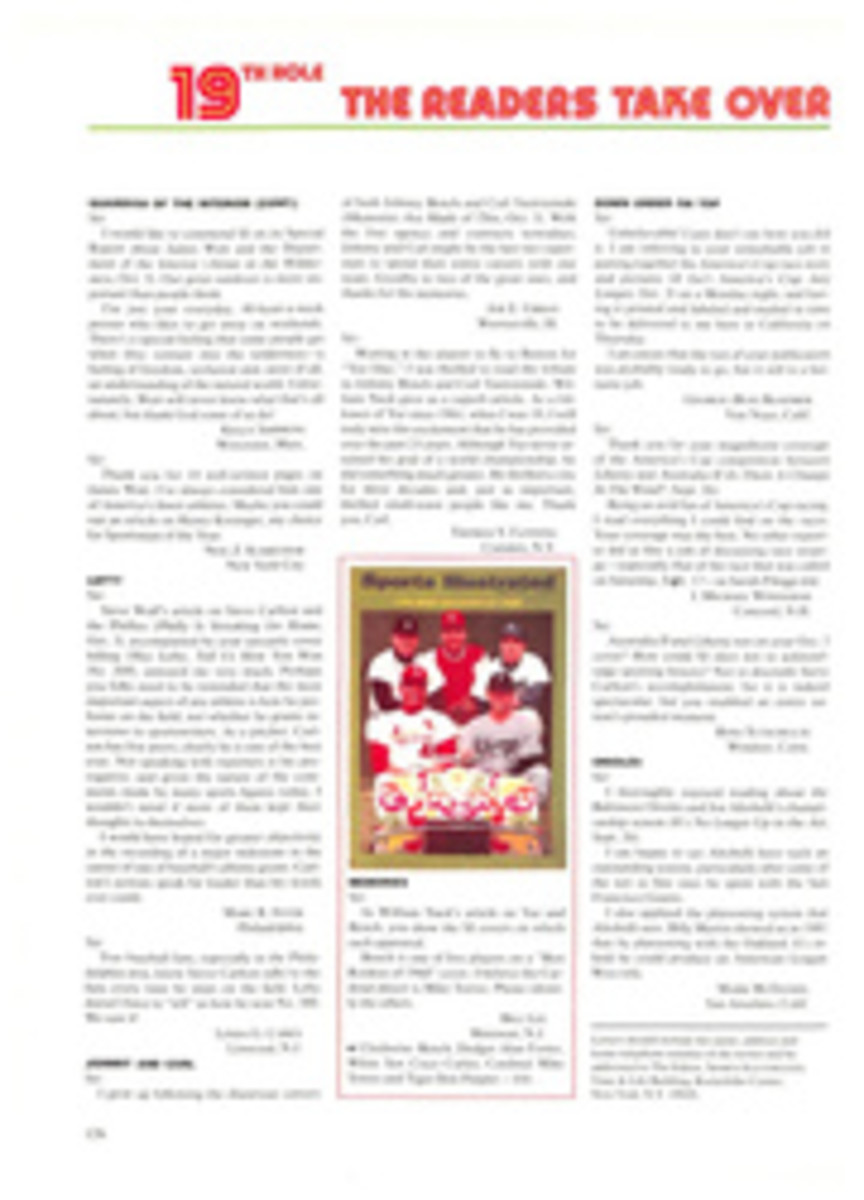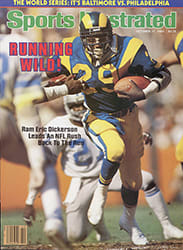
TO SAVE HIS ARM, A PITCHER SHOULD USE HIS HEAD AND STUDY MECHANICS
Major league baseball is beginning to change its philosophy for the treatment of the arm and shoulder injuries that have long plagued pitchers. Instead of relying on drugs or surgery to fix the damage, the emphasis now is on preventing, rather than repairing, that damage. In the last three years new diagnostic techniques, million-dollar grants from hospitals and refinements in high-speed, stop-action videotaping have provided new answers to old problems.
"The beauty of the new philosophy," says Dr. Frank Jobe of Los Angeles, the foremost sports orthopedist in the country, "is that it's so simple. Essentially, it means writing the word 'prevention' on a flag and waving it very, very high."
But prevention is nothing more than a buzz word until it's given definition by such surgeons as Jobe and Dr. H. Paul Bauer of San Diego. In their terms, prevention is a commitment by both player and management not only to remember how sensitive the arm and shoulder are to stress but also to recognize and support the new methods. It means placing increased importance on good body mechanics—getting the body into the proper position to pitch. It means adhering to a daily regimen of strength and isometric and isokinetic flexibility exercises. New York Mets Pitcher Tom Seaver has been at the forefront of the prevention movement for years. Today he is regarded as an authority on how to coax "consistency and longevity" out of a pitcher. "What you're really looking for in a prevention program," says Seaver, who's working on a book about body mechanics and pitching, "is strength and flexibility through the entire range of motion. You don't want weak points anywhere. But before that happens, you must have a general understanding of the proper way to pitch. If you don't, and continue to throw improperly, you're going to have a breakdown."
Many experts believe the treatment of one such breakdown—that of the Pittsburgh Pirates' star lefthander, John Candelaria—triggered baseball's swelling interest in antisurgery medicine. On May 10, 1981 in St. Louis, Candelaria threw a pitch that put his career in jeopardy. Less than 24 hours later he was in Atlanta, consulting with an orthopedic specialist. Candelaria remembers the doctor telling him: "Son, it's a tear in your biceps tendon. I recommend immediate surgery."
"My first reaction was, 'Whoa, let's get another opinion,' " Candelaria says.
He did, but the second physician confirmed the wisdom of the proposed treatment. Baseball, after all, was then deep into its surgery-as-a-cure phase, which was popularized in 1974 when Jobe reconstructed the left elbow of Pitcher Tommy John. What concerned Candelaria wasn't the operation he faced, but its consequences. John's extraordinary recovery aside, other subsequent efforts to restore pitching arms and shoulders through surgery had failed abysmally. Steve Busby, Steve Stone, Wayne Garland, Don Gullett and Doug Rau—to name a few top pitchers—had seen their careers shortened or ended following surgery.
Candelaria eschewed surgery and instead turned to Bauer. A former San Diego Padres team doctor (1969-80), Bauer had gained considerable attention in medical circles, but little acceptance, as early as 1979 when he became an outspoken critic of rotator cuff surgery. (The rotator cuff is made up of four muscles that secure the arm to the shoulder socket, and pitching puts tremendous stress on that area.) "The results just haven't been very good," Bauer maintains. He was the first physician to suggest the use of good body mechanics as an alternative to rotator cuff and other arm surgery, a theory he developed through discussions with Seaver, who was then pitching in Cincinnati. Seaver had introduced Bauer to proper pitching body mechanics in 1979 when the doctor became frustrated during his treatment of Mark Fidrych. "Tom taught me a great deal," says Bauer. "I believe he's unsurpassed in his knowledge of pitching and the mechanics of throwing a baseball."
Bauer's belief in the efficacy of good body mechanics was so strong that he opened The Body Mechanics Lab in San Diego in 1979. Before Candelaria came along, Bauer's most notable patients had been Randy Jones and Bob Shirley, who were then with the Padres. That Bauer's ideas were largely untested mattered little to Candelaria. "I got good feelings from Dr. Bauer," he says. "He was so confident. I was impressed by him."
Bauer immediately diagnosed not a tear in the biceps tendon, but a nerve problem in Candelaria's left shoulder as the cause of the numbness and pain in Candelaria's left elbow and forearm. Bauer advised six to eight months of rehabilitation and some slight modifications in the Candy Man's motion.
That summer, Candelaria worked diligently with the lab's day-to-day director, Fred Kendall, a tobacco-chewing former major league catcher, whose 795 games behind home plate during his 12-year career had taught him a thing or two about pitching. They spent hours in the lab, an alley-like 12' X 80' AstroTurf-carpeted room complete with a pitcher's mound and a $55,000 Instar videotape system. The Instar system utilizes two cameras, which can be focused on various parts of the body during delivery. Because of Instar's advanced capabilities, the two-camera system can produce detailed images of objects in motion on a TV screen. Split-screen and isolation shots also are available at up to 140 frames per second. "Realizing what you're doing wrong is half the battle," says Kendall. "With videotape we can stop the delivery every step of the way, back it up, isolate areas. It makes it easier for players to understand their problems."
Candelaria's arm ailment, it was discovered, stemmed from two major flaws in his delivery. Nothing unusual, really. Kendall believes that 80% of major league pitchers are guilty of one or more of four basic mechanical mistakes. Candelaria was landing on his right heel instead of on the ball of his foot and thereby was losing what's now commonly called "glove drive," i.e., getting additional forward momentum and focused direction during delivery. His bad landings were causing his body and shoulder to be shocked on every pitch, and the loss of glove drive was weakening his push toward home plate. With his glove at shoulder height or lower, Candelaria was missing an opportunity to generate positive momentum and was forcing his arm and shoulder to pick up the slack.
Other common mistakes, according to Bauer, Seaver and Kendall, include not keeping one's "front" shoulder and hip facing home plate during the push-off and not using the legs and trunk to throw. Both errors dramatically increase arm and shoulder stress.
"It took a while to make the changes," says Candelaria. "I spent a lot of time in front of the mirror. You can't make adjustments like that in the middle of a season." But two years and 27 wins later, he's thankful he did. "I owe it all to Dr. Bauer and Fred," Candelaria says. "Every damn bit of it. I believed in myself, but they're the ones who showed me what to do. Without them I don't think I'd be pitching today."
Candelaria's recovery offered hope for pitchers faced with similar pain but who were ignorant of or afraid to try the anti-surgery option. It also awakened the baseball establishment to the advantages of antisurgery treatment. "Before, all management had to do was replace one $30,000 pitcher with another," says Jobe. "Now, with guys making $700,000 a year, the emphasis has shifted to saving these people."
No one has made a bigger about-face in his thinking than Jobe. Between 1967 and '82 he performed more than 100 rotator cuff operations, but he's now opposed to the operation in certain instances. His shift stems from three years of research begun in 1980 under a $1 million grant from L.A.'s Centinela Hospital to Jobe's Biomechanics Lab in Ingle-wood, Calif. In one of his studies, hair-thin wires were inserted into the arms of five male test subjects. Muscle firings were recorded during various stages of windup and delivery. The test results, published in the January 1983 American Journal of Sports Medicine, startled many doctors. The two major findings: a surprising lack of muscle activity during the arm's acceleration phase, when it can reach 700 mph; and a tremendous burst of activity during the arm's deceleration phase, when the shoulder is slowing the arm's motion. "I found that deceleration data kind of surprising myself," Jobe admits.
During the course of his study Jobe also discovered healthy rotator cuff muscles weaken after 10 days of inactivity, setting off a chain reaction he believes responsible for most, if not all, arm and shoulder ailments. "It means as early as the third inning of pitching you will have trouble keeping your shoulder up," says Jobe. "And because the shoulder is weak from inactivity, you can feel pain. You then lower that shoulder to ease that pain. That lowers your arm, which, in turn, puts abnormal stress on the elbow."
It seems so simple. A weak shoulder plus pain equals an altered motion and more pain. Jobe's solution was just as simple: Strengthen the shoulder through a series of eight basic dumbbell exercises so it can stay elevated and withstand the stress of the sudden starting and stopping. "The Dodgers have been doing a variation of these exercises for about three years now," says Jobe, who also is L.A.'s team doctor, "and we haven't had any shoulder problems in that time."
Still, as elementary as this new philosophy sounds, changing old habits isn't easy. Adding preventive exercises to the regular training regimen sometimes annoys pitchers who feel fine. And many major league pitchers shudder at the thought of changing their mechanics. Most have pitched the same way since Little League, and they fear that any adjustment in their motion will have disastrous consequences. That fear seems to be more common among older, more established pitchers whose mechanics are firmly entrenched. "It would be so much better," Kendall says, "if pitchers could change while they're pain-free. Why not change now and avoid trouble later?"
Good question. One answer may be that baseball has never instituted a broad-based education program. Before Jobe's study, little scientific data were available on what happens to the arm during delivery. Without such data, few physicians or clubs were willing to prescribe weight training (which was long a baseball taboo), isometric exercise or even acupuncture as possible cures. But even as Jobe's findings make their way around the league and new rotator cuff-strengthening machines, such as the one developed by Atlanta Braves trainer Dave Pursley, hit the market, baseball drags its feet. Few franchises have made a strong commitment to solving the injury problem.
"Face it," says Jobe, "baseball is a very traditional game. It's hard for a doctor to tell a major league pitching coach he thinks Pete Vuckovich can pitch longer if he modifies his mechanics a bit—especially as Pete is picking up his Cy Young Award."
"I'm making more progress with Little League than with the big leagues," says Bauer.
But neither Jobe nor Bauer is worried. They know it's only a matter of time until preventive medicine goes from a solution that is warming up in the bullpen to one that is in the game.

